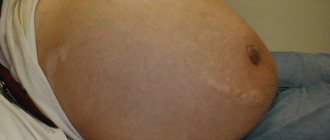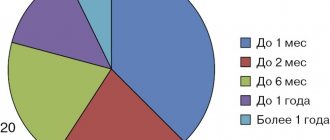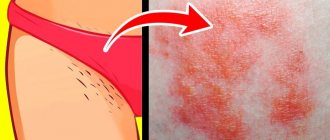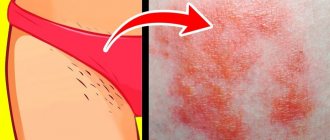Hemorrhagic vasculitis: photos, causes and methods of treatment in children and adults
Hemorrhagic vasculitis is also called allergic purpura, capillary toxicosis, or, after the names of the authors who described it, Henoch-Schönlein disease. The disease is part of a large group of vasculitis, inflammation of blood vessels of various types and sizes.
The peculiarity of the reaction of the vascular wall is aseptic conditions (absence of a pathogen) and the dominant role of a pronounced allergic reaction. The disease is accompanied by increased thrombus formation, impaired blood microcirculation in tissues and internal organs, which leads to damage to the kidneys, joints, and digestive organs.
Men under 20 years of age and children from 7 to 13 years of age are more susceptible to capillarotoxicosis. The incidence in these populations ranges from 14 to 24 per 10,000.
Causes
The causes of the disease have not been precisely established. It is considered to be autoimmune. However, a connection with factors activating pathological processes has been identified. These include:
- traumatic damage to the skin and blood vessels;
- transferred viral and bacterial infectious diseases, of particular importance is given to acute and chronic inflammation in the upper respiratory tract (influenza, ARVI, tonsillitis, sinusitis), measles, frequent sore throats, chicken pox, typhus, streptococcal diseases;
- vaccinations during routine vaccination, prophylactic use of immunoglobulins;
- food allergies;
- restructuring of the body during malignant and benign tumors;
- changes in women during pregnancy;
- the influence of increased doses of solar radiation (with prolonged tanning), temperature fluctuations, radiation;
- allergic reactions to medications (usually antibiotics, sedatives and antihypertensive drugs);
- metabolic disorders in endocrine diseases (diabetes mellitus);
- genetic predisposition in the family.
- household and professional poisoning, toxic infection;
- in children - helminthic infestations;
- reaction to insect bites.
Hemorrhagic vasculitis in adults develops more often in old age, with weak and impaired immunity.
Frequently asked questions about vasculitis
How does vasculitis manifest?
This disease has many symptoms. Common symptoms include malaise, fever, changes in blood pressure and disturbances in the circulatory system.
Why is vasculitis dangerous?
Vasculitis is an insidious disease that leads to tissue destruction and dysfunction of vital organs.
What happens if vasculitis is not treated?
Without proper treatment, the disease will progress and become more complicated, often resulting in disability or death.
Symptoms of hemorrhagic vasculitis, photo
Manifestations of the disease depend on which organs and systems are affected. Hemorrhagic vasculitis can manifest itself in one or more groups of symptoms (see photo). The main ones are the following:
- skin lesions;
- joint damage;
- lesions of the gastrointestinal tract;
- renal syndrome;
- in isolated cases - damage to the lungs and nervous system.
The most characteristic is the acute onset of the disease, accompanied by an increase in temperature to febrile levels. There may be cases when there is no increase in temperature.
- Skin syndrome (or purpura) occurs in every patient. It manifests itself in the form of a symmetrical small-spotted or maculopapular hemorrhagic rash, localized mainly on the extensor surfaces of the lower (less often upper) extremities, around large joints and on the buttocks. The rash can be represented by single elements, or it can be intense, combined with angioedema. As a rule, the rashes are recurrent and wave-like. When the rash fades, the pigmentation remains. In case of frequent relapses, peeling of the skin occurs at the site of the rash.
- Articular syndrome is often observed simultaneously with skin syndrome; it is most typical for adults. Most often, the process involves the large joints of the legs, most rarely the elbows and wrists. Pain, redness and swelling are noted. Typical for hemorrhagic vasculitis is the volatile nature of articular lesions. In 25% of cases, migrating joint pain precedes skin lesions. Joint syndrome, which rarely lasts more than a week, is sometimes combined with myalgia and swelling of the lower extremities.
- Abdominal syndrome is also observed in 2/3 patients. It is characterized by spastic abdominal pain, nausea, vomiting, and gastric bleeding. However, truly life-threatening phenomena are observed only in 5% of patients.
- Renal syndrome is observed less frequently (from 40 to 60% of cases) and does not develop immediately. It manifests itself in the form of hematuria (blood excretion in the urine) of varying severity; in rare cases, the development of glomerulonephritis (kidney inflammation) of the hematuric or nephrotic form is possible. More often, glomerulonephritis manifests itself in the first year of the disease, less often it occurs during the next relapse of hemorrhagic vasculitis or after the disappearance of all other manifestations of the disease.
In isolated cases, pulmonary complaints are observed - bleeding, hemorrhages. Damage to the nervous system also rarely occurs - headaches, convulsions, and the possible development of encephalopathy or polyneuropathy.
Hemorrhagic vasculitis in children
Symptoms of vasculitis in children, depending on the frequency of their occurrence, are distributed as follows:
- rash in the form of papules and red spots – 100% of cases
- arthritis and joint pain – 82%
- abdominal pain – 63%
- kidney damage (glomerulonephritis) – 5-15%.
Most often, recovery occurs spontaneously. Therefore, the disease is relatively favorable in childhood, especially if nutritional rules are followed and the possible causative factor is eliminated. After inflammation subsides, the risk of relapse is greatest in the first 3 months, but may occur later.
After recovery, you should adhere to the principles of dietary nutrition throughout the year and avoid contact with allergens that enter through the respiratory tract.
Skin syndrome is the leading one in the clinical picture of vasculitis. It is characterized by the following features:
- the appearance of a rash called purpura;
- its symmetry;
- purpura rises above the skin and is easily palpated;
- at the same time there may be red spots, pimples, blisters, which are characterized by itching;
- primary rashes on the feet, later they spread to the thighs and buttocks;
- after a couple of days, the rash turns from bright red to brown, and then turns pale and disappears;
- Sometimes pigmented lesions may remain and persist for a long time.
The development of glomerulonephritis usually occurs a month after the appearance of the first symptoms of the disease. Kidney damage can occur with minimal symptoms or be prone to an aggressive course. Depending on this, the clinical and laboratory signs of glomerulonephritis are very diverse. They include:
- protein in urine;
- edema, sometimes very pronounced as part of nephrotic syndrome, in which protein loss in the urine can reach 3.5 g per day;
- pain in the lumbar region;
- redness of urine (macrohematuria) or only microscopically detectable presence of red blood cells in it (microhematuria);
- transient increase in pressure.
Abdominal syndrome is a consequence of intestinal ischemia. In children it is characterized by:
- nausea;
- vomit;
- the appearance of bloody streaks in the stool;
- diffuse pain throughout the abdomen, like colic;
- pain intensifies after eating;
- loose stool.
The abdominal form of hemorrhagic vasculitis resembles an “acute abdomen”, traditionally requiring surgical intervention. However, for this disease it is contraindicated, because the reason is vascular damage. Adequate drug therapy is required.
Articular syndrome in hemorrhagic vasculitis has typical symptoms that distinguish it from articular syndrome in other diseases (osteoarthrosis, rheumatoid arthritis, gout). These include:
- absence of joint destruction;
- symmetry of the lesion;
- no migration of pain;
- frequent damage to the ankle and knee joints.
Treatment of a child with hemorrhagic vasculitis must begin in a hospital setting. Three weeks of bed rest followed by extension is usually suggested.
How is hemorrhagic vasculitis diagnosed?
Henoch-Schönlein disease is quite easy to diagnose in a patient who has all three main symptoms.
There are slight differences in the course of the disease in children and adults.
In children:
- More than 30% of children develop fever.
- Characteristic is the acute onset and course of the disease.
- Abdominal syndrome is accompanied by loose stool streaked with blood.
- Often the kidneys are involved in the process from the very beginning, with hematuria and proteinuria detected in urine tests.
In adults:
- The onset of the disease is delayed, the symptoms are milder.
- Abdominal syndrome occurs in only 50% of patients and is rarely accompanied by nausea and vomiting.
- Kidney damage leads to the development of chronic diffuse glomerulonephritis, with the formation of chronic renal failure.
Consequences and complications
If the disease is not treated on time, the following complications may occur:
- liver and kidney failure;
- abdominal abscesses
- pulmonary hemorrhage;
- intussusception;
- polyneuropathy.
If, as the disease progresses, part of a blood vessel stretches and dilates, the risk of an aneurysm .
If during the inflammatory process the vessels narrow, the blood supply to individual organs and tissues may stop, which increases the likelihood of necrosis.
Diagnostics
Diagnosis of the disease is carried out comprehensively. First of all, the doctor conducts an oral interview, during which he clarifies the patient’s complaints and collects an anamnesis. In the future, the following studies may be prescribed:
- Ultrasound of the abdominal organs and kidneys.
- Determination of bleeding duration.
- Carrying out a cuff test, as well as a tourniquet and pinch test.
- Fecal examination.
- Conducting immunological studies, as well as blood biochemistry.
- Virological studies to detect hepatitis.
- Carrying out endoscopic examination of the gastrointestinal tract.
- A blood test can reveal an increased number of leukocytes and ESR. Immunological disorders are also observed in the form of an increase in immunoglobulin A and a decrease in the level of immunoglobulin G.
- During the physical examination, the doctor checks the functioning of the joints and carefully examines the skin to identify changes in their color and possible rashes. If swelling is detected in the facial area, this may indicate a disruption in the normal functioning of the urinary system. You should also check your pulse.
The disease should be distinguished from the following ailments and conditions:
- Infectious endocarditis.
- Systemic vasculitis (Goodpasture's syndrome, periarteritis nodosa, Behçet's disease).
- Diffuse connective tissue diseases (systemic lupus erythematosus).
- Meningococcemia.
- Macroglobulinemic Waldenström's purpura.
- Yersiniosis.
- Crohn's disease.
Additionally, a trepanobiopsy procedure and bone marrow examination may be prescribed.
Types and classification of vasculitis
Vasculitis is one of the most serious diseases. The inflammatory process can affect both small vessels of the circulatory system (capillaries, arterioles and venules) and large ones (aorta and its large branches). The affected blood vessels can be located shallowly under the skin, in the internal organs themselves and in any cavities.
Depending on the cause of the disease, there are 2 types of systemic vasculitis:
- primary vasculitis (identified as an independent disease in which the vessels themselves become inflamed);
- secondary vasculitis (appears as a result of other diseases or is the body’s reaction to an infection).
According to the generally accepted classification, primary vasculitis can be divided into three groups, depending on the size of the inflamed vessels:
- inflammation of small vessels (hemorrhagic vasculitis (Henoch-Schönlein purpura), Wegener's granulomatosis (vasculitis), microscopic polyangiitis, cryoglobulinemic vasculitis, Charge-Strauss syndrome);
- inflammation of the middle vessels (periarteritis nodosa, Kawasaki disease);
- inflammation of large vessels (giant cell arteritis (or temporal arteritis, Horton's disease), Takayasu's disease);
There is also isolated “skin vasculitis”, which can be a manifestation of the following diseases:
- (hypersensitive allergic vasculitis, Henoch-Schönlein hemorrhagic vasculitis;
- erythema nodosum, vasculitis nodosum, periarteritis nodosum).
Vasculitis can also affect various human organs:
vasculitis of the brain, vasculitis of the lungs, vasculitis of the lower extremities, vasculitis of the eyes. Eyes with vasculitis can be very damaged (inflammation of the retinal arteries can lead to hemorrhages and partial loss of vision).
Usually people who first encounter this disease are interested in whether vasculitis is contagious. Primary vasculitis is not contagious and is not dangerous to others, but secondary (infectious) vasculitis, which appears against the background of infectious diseases, such as meningitis, can pose an epidemic danger.
Vasculitis during pregnancy can not only provoke delayed fetal development, but also lead to miscarriage.
Treatment of hemorrhagic vasculitis
First, you need a diet (allergenic foods are excluded). Secondly, strict bed rest. Thirdly, drug therapy (antiplatelet agents, anticoagulants, corticosteroids, immunosuppressants - azathioprine, as well as antithrombotic therapy).
The following drugs are used:
- activators of fibrinolysis - nicotinic acid.
- heparin in a dosage of 200-700 units per kilogram of body weight per day subcutaneously or intravenously 4 times a day, gradually withdrawn with a decrease in the single dose.
- disaggregants - chimes 2-4 milligrams/kilogram per day, trental intravenous drip.
- In severe cases, plasmapheresis or glucocorticosteroid therapy is prescribed.
- In exceptional cases, cytostatics such as Azathioprine or Cyclophosphamide are used.
In general, the course of the disease is favorable, and immunosuppressive or cytostatic therapy is rarely used (for example, in the development of autoimmune nephritis).
- The duration of treatment for hemorrhagic vasculitis depends on the clinical form and severity: 2-3 months - for mild cases; 4-6 months - for moderate cases; up to 12 months - with severe recurrent course and Schönlein-Henoch nephritis; in case of chronic course, treatment is carried out with repeated courses for 3-6 months.
Children must be registered at a dispensary. Conducted over 2 years. For the first 6 months, the patient visits the doctor monthly, then once every 3 months, then once every 6 months. Prevention is carried out by sanitation of foci of chronic infection. Regularly examine stool for helminth eggs. Such children are contraindicated in sports, various physical procedures and exposure to the sun.
Answers on questions
What is meant by a hypoallergenic diet?
- First of all, highly allergenic foods should be excluded from consumption, such as eggs, chocolate, citrus fruits, coffee and cocoa, sea fish and seafood, and nuts. It is also necessary to avoid fatty and fried foods. The diet should be dominated by low-fat dairy products, stewed and boiled dishes. Green apples, cereal porridges, turkey and rabbit meat, and vegetable oils are allowed.
What is the prognosis for hemorrhagic vasculitis?
- As a rule, the prognosis, especially for mild forms of the disease, is favorable. Severe hemorrhagic vasculitis is fraught with recurrence of the disease and the occurrence of complications (nephritis complicated by renal failure). With the fulminant form, there is a high probability of death within a few days after the onset of the disease.
Are patients who have suffered hemorrhagic vasculitis taken to the dispensary?
- Clinical follow-up in adults after illness is not indicated. Children must be monitored for two years. Monthly for the first six months, quarterly for the next six months, and every 6 months for the last year. Children should not play sports; physiotherapy and insolation (sun exposure) are contraindicated for them.
Is it possible to develop complications and consequences after hemorrhagic vasculitis and what are they?
- Yes, the disease can lead to intestinal obstruction and peritonitis, chronic renal failure, dysfunction of internal organs (heart, liver), anemia and pulmonary hemorrhages; in children, hemorrhagic diathesis may develop.
Diet
Hypoallergenic diet
- Efficacy: therapeutic effect after 21-40 days
- Timing: constantly
- Cost of products: 1300-1400 rubles. in Week
During illness, it is important to exclude from the diet all foods that can provoke allergic reactions. It is necessary to completely remove chocolate, cocoa, eggs, and citrus fruits from the diet. If you have kidney failure, you should not eat too salty foods or foods containing a lot of potassium. Alcohol should be completely avoided and food should not be too cold or too hot.
It is important to adhere to the following recommendations:
- Eat in small portions and at least 6 times a day.
- Introduce foods containing vitamins C, B, K and A into your diet.
- The amount of salt per day should not exceed 8 g.
- It is important to eat plenty of fermented milk products to restore calcium reserves in the body.
- The menu should include vegetable soups, boiled vegetables, cereals with milk and regular ones, vegetable oils, sweet fruits, boiled meat and fish, white bread crackers.
- You need to drink green tea, herbal infusions, jelly and compotes.
- As you recover, the diet is adjusted.
How to prevent exacerbations?
After discharge from the hospital, the patient should not forget about his illness at home. Of course, by that time he will already know everything about the nature of the disease, prevention of exacerbations, behavior in everyday life, nutrition and daily routine. Having immersed himself in a homely atmosphere, the patient will not take any medications without a doctor’s prescription, will not attack foods that can provoke a relapse (allergens), but will eat well and will take quiet, easy walks in the fresh air every evening.
In addition, the following are contraindicated for a person:
- Excessive anxiety, mental stress;
- Vaccinations (possible only for health reasons);
- Hard physical labor (children are exempt from physical education lessons);
- Hypothermia;
- Administration of immunoglobulins (antistaphylococcal, antitetanus, etc.).
Due to the fact that hemorrhagic vasculitis is predominantly a childhood disease, special recommendations are provided for children (or parents?):
- Every six months the child visits the attending physician (in the absence of exacerbations);
- Clinical observation for at least 5 years if the kidneys remain healthy, but if they are damaged, control may be lifelong;
- Children are completely exempt from physical education for a year, then move to the preparatory group;
- A mandatory visit to the dentist and otolaryngologist is required 3 times a year;
- Regular urine tests (general and Nechiporenko) and fecal tests for helminths;
- Vaccinations are excluded for 2 years, and after this time, routine vaccination is carried out, but with the permission of the attending physician and under “antihistamine cover”;
- Compliance with an anti-allergenic diet – 2 years;
Advice to parents or other relatives about treatment at home, relapse prevention, nutrition and behavior at school and at home.










